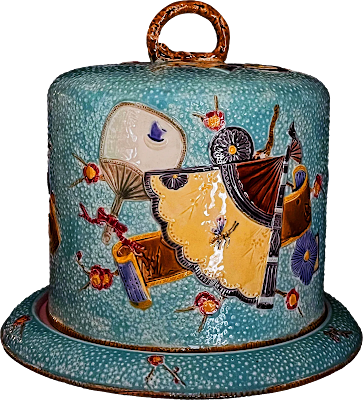Some of the most impressive group of majolica wares potted during the height or British majolica production originated at the Simon Fielding factory at Stoke-on-Trent.
The pottery which began as a consortium of five partners, originated as Hackney, Kirkham & Company in 1878 at the Railway Pottery. Shortly after it’s founding J. Kirkham dropped out as a partner, leaving four original partners, Frederick Hackney, Simon Fielding, Enoch Massy and Joseph Ball to operate under the name of F. Hackney & Co. They immediately began on the production of the latest fad in pottery, majolica.
Hackney & Co. oyster plate
Hackney trade ad from Pottery Gazette, July, 1878
In November of 1879 that partnership was dissolved leaving sole original partner, Simon Fielding, to operate under the name of S. Fielding & Company. In 1892, son Abraham Fielding took over the reigns of running the firm after Simon Fielding retired.
Map showing the location of the Railway Pottery
Original Railway Pottery building
One of the bottle kilns in the Railway Pottery
Another view of the Railway Pottery
The company specialized in earthenware and majolica manufacture. While the period of majolica manufacture was relatively brief, it remains one of the jewels of the company’s history.
Fielding trade ad describing their various pottery lines
Trade ad Pottery Gazette December 1879
Fielding ad showing the Hare umbrella stand and Stork garden seat
Fielding trade ad
The company embraced the Japonisme so popular during the period, incorporating it into many of their designs. They also adopted Wedgwood’s brand name
Argenta to describe their ivory ground majolica with pastel decoration.
They made a diverse variety of majolica. Fielding created tea sets and teapots...
Drum shaped Prunus tea set
Fielding Shell and Net tea set
Fielding Fan tea set
Fielding Ribbon and Leaf pattern
Fielding parrot teapot
Fielding parrot tea kettle
Fielding Fuchsia teapot
Fielding Fuchsia sugar bowl
...umbrella and cane stands…
Fielding Hare umbrella stand
Fielding Fan umbrella stand Argenta flying heron cane stand Fielding crane umbrella stand
Fielding Aesthetic Movement stand
…oyster plates…
Unusual crescent shaped oyster plate
Fielding’s most popular oyster plate came in a variety of color treatments
Fielding Fan oyster plate
An adaptation of the Minton oyster plate identical to
the Hackney & Co. oyster
… decorative plaques…
Fielding plaque in the barbotine style
Fielding plaque in the barbotine style
…serving dishes and plates…
Fielding Argenta version of the Hackney & Co. fox dish
Fielding Ribbon and Leaf platter
Fielding majolica Daisy bread plate
Fielding Shell and Net platter
Fielding Daisy dessert set
Fielding Fan cake plate
Fielding majolica Fan plate
Fielding Fan majolica side dish
Fielding Ribbon and Leaf cake plate
Fielding Shell and Net cake plate
Shell and Net dessert plate
Fielding parrot dessert plate
Shell and Net ice cream set
Fielding hummingbird ice cream tray
Fielding Fan ice cream tray
Fielding Fan relish dish
…pitchers…
Fielding hummingbird pitcher
Fielding Aesthetic Movement pitcher
Fielding milkmaid pitcher
Fielding shell form pitcher
Fielding butterfly lip pitcher
Fielding Daisy pitcher
Fielding Shell and Net pitcher
Fielding bird and squirrel pitcher
Fielding Ribbon and Leaf pitcher
Fielding squirrel piitcher
Fielding Daisy syrup pitcher
... cups and saucers...
Fielding Ribbon cup and saucer
Fielding Daisy mustache cup and saucer
Fielding butterfly mustache cup and saucer
Fielding Shell and Net mustache cup and saucer
… covered butter and cheese dishes…
Fielding Daisy butter dish
...compotes and dessert stands...
Fielding Daisy compote
Fielding butterfly series compote
Fielding Shell and Net compote
Shell and Net dessert stand
Fielding butterfly and Prunus dessert stand
Ribbon and Leaf low dessert stand
Ribbon and Leaf tall dessert stand
…butter pats…
Fielding Fan butter pat
Fielding Fan butter pat
Fielding butterfly series butter pat
Fielding Daisy butter pat
Fielding Shell and Net butter pat
…sardine boxes…
Shell sardine box attributed to Fielding
Fielding Fan sardine box
…jardinieres…
Fielding parrot jardiniere
Fielding copy of a Minton design
...an unusual fan shaped basket...
…and garden seats.
Fielding emu garden seat
Fielding Stork garden seat
Like any successful pottery Fielding had problems with their designs being copied. The primary offender was Hawley & Co. who in addition to copying Fielding’s designs, had also copied
Wedgwood's Ocean design. Fielding sued them for copyright infringement for copies of both
Daisy and
Fan. Hawley lost the case and had to pay a fine. They later registered their own versions of these designs. Harley & Co. copies of Fielding designs are sometimes marked with a Fleur de Lis within a shield.
Hawley & Co. punch bowl, a copy of Fielding
Hawley & Co. butter pat, a copy of Fielding’s Daisy
Hawley & Co. majolica plate
Hawley & Co registered design mustache cup and saucer,
a copy of Fielding’s Daisy pattern
Butter dish attributed to Hawley & Co.
Fan butter pat attributed to Hawley & Co.
Mark for Hawley & Co.’s Fielding copies
In little more than a decade, the majolica production at Fielding had run its course and was no longer considered a priority. By 1891 the company was no longer advertising its majolica products so it had probably ceased or severely scaled down its production, as these ads from 1891 and 1894 show.
The Pottery Gazette, December 1, 1891
The Pottery Gazette, December 1, 1894
Fielding majolica is occasionally marked with an impressed straight impressed line. The mark below is from Fielding’s registered Fan design.
Fielding impressed mark.
In 1912 the pottery name was changed from the Railway Pottery to the Crown Devon Works, taking on the name of Fielding’s most popular china brand.
Crown Devon Works, c.1965
The company remained in production for over 100 years producing a large range of china lines until finally closing in 1982. The Crown Devon Works was demolished in 1987.


































































































No comments:
Post a Comment